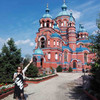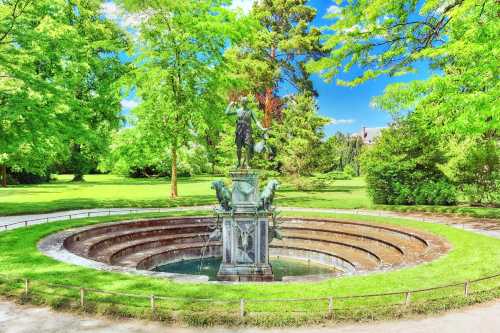App
Customer Support
Find Bookings
#JulyTravelSupport We arrived at Fontainebleau after taking the train early in the morning from Paris and driving for about an hour. The first thing I felt as soon as I got off at the city was the difference in the air. In a quiet and secluded atmosphere, the smell of trees and the morning sunlight blended softly. 🌿 Let's start with a walk in the forest Fontainebleau is famous for the wide and beautiful Fontainebleau Forest (Forêt de Fontainebleau), which is called the 'Forest of the King'. The path that unfolds from the entrance is flat and easy to walk, so it's perfect for anyone to take a walk. 🏰 The Palace of Fontainebleau is truly magnificent After walking slowly through the forest, we headed to **Château de Fontainebleau** right next to it. This is the palace where Napoleon I stayed, and it is said to have a history of over 800 years. The exterior of the building was beautiful, but the moment I looked around the interior, I felt like my breath was taken away. Gorgeous chandeliers, marble staircases, murals and gold decorations... Each one was like a work of art, and the weight of history could be felt. #ParisTravel #ParisSuburbsTravel
roaduntraveled_inlife
Château de Fontainebleau: A Piece of French History You Can Walk Through If you ask a French person to name a château that really tells the story of France, chances are they’ll say Fontainebleau. Sure, Versailles gets all the fame, but Fontainebleau? That’s where our history lived. It’s a place that feels more real—less like a museum and more like a window into eight centuries of French life. A Home for Kings, Emperors… and Artists Fontainebleau isn’t just another royal residence. It’s the only château in France that was lived in by almost every king or emperor from the Middle Ages to Napoleon III. Imagine that—so many different rulers, styles, and decisions, all in one place. François I, one of our Renaissance kings, really kicked things off in the 1500s. He brought in Italian artists and turned Fontainebleau into a proper palace, full of art and beauty. He’s also the one who made that famous Galerie François I, full of gorgeous frescoes and carvings. It’s basically where the French Renaissance got its groove. Later on, Napoleon loved Fontainebleau too. In fact, it’s where he said goodbye to his soldiers in 1814, right on the grand staircase that still gives people goosebumps today. A Mix of Styles, But All French What’s cool about Fontainebleau is that it doesn’t stick to one style. It’s a mix—Renaissance here, Baroque there, with a bit of Napoleon’s Empire style thrown in. But somehow, it all works together. It feels like a reflection of France itself: complex, layered, elegant. And let’s not forget the gardens. Designed by the best of the best (including André Le Nôtre, who also did Versailles), they’re peaceful, grand, and full of little surprises. Why It Matters to Us For us French, Fontainebleau is more than just a historical building. It’s personal. It’s where major moments in our history happened—not just the fancy stuff, but also the human side of power: love stories, political drama, artistic dreams, even defeat. Walking through Fontainebleau isn’t like flipping through a history book. It’s like being in the story. And that’s something we’re really proud of. So if you’re ever in France and want to understand a bit more about what shaped our country—not just the kings and wars, but the art, the style, the soul—Fontainebleau is the place to go.#france #castle
Langsuan
Popular Trip Moments
Romance Found Near Paris: Fontainebleau | Fontainebleau Palace – A Day in Paris, Walking Through the King's Garden | Fontainebleau Palace – A Journey Through French Royal History | 🇫🇷 Château de Fontainebleau Guide|The luxurious palace of the French royal family | 🏰 Château de Fontainebleau – Intimate Majesty Beyond Versailles | 🏰 Fontainebleau Palace | Perfect Weekend Getaway from Paris | 5-Day Tour in France - Customized Itinerary to Go Off the Beaten Path | Around Paris, France|The niche castle Fontainebleau | A Super Detailed 13-Day Travel Guide Across Europe | Travel Guide to Fontainebleau Palace in France | 13-Day France, Italy, and Switzerland Tour: A Feast for the Eyes | 9 Must-Visit Destinations in France | 13-day trip through France, Italy and Switzerland: Explore European history in museums | 🌟 Palace of Fontainebleau: A French landmark where you can enjoy history and tranquility 🌿 | Fontainebleau Forest | Fontainebleau is a real gem! | Fontainebleau Palace: A must-visit if you have time, the French royal heritage | Fontainebleau Palace - one of the UNESCO World Heritage Sites, a castle that has served dozens of monarchs | The Royal Palace was built in the 12th century: Napoleon's throne room - Fontainebleau Palace | I have finally arrived at the other side of the Anywhere Door, Fontainebleau, the spring, palace, and forest described by Zhu Ziqing | Hiking through Fontainebleau | Fontainebleau, France | A must-visit in France is the Fontainebleau Forest, immersing yourself in the world of oil painting | Napoleon's Imperial Apartments 🛋️👑 | [France/Fontainebleau] Enjoy an elegant and affordable morning in the French countryside | Château Fontainebleau Palace near Paris, France | Fontainebleau Palace near Paris
Recommended Attractions at Popular Destinations
Popular Attractions in Bangkok | Popular Attractions in Manila | Popular Attractions in Tokyo | Popular Attractions in Taipei | Popular Attractions in Hong Kong | Popular Attractions in Seoul | Popular Attractions in Kuala Lumpur | Popular Attractions in Los Angeles | Popular Attractions in Shanghai | Popular Attractions in New York | Popular Attractions in Shenzhen | Popular Attractions in Osaka | Popular Attractions in Singapore | Popular Attractions in London | Popular Attractions in Guangzhou | Popular Attractions in San Francisco | Popular Attractions in Beijing | Popular Attractions in Macau | Popular Attractions in Bali | Popular Attractions in Jakarta | Popular Attractions in Paris | Popular Attractions in Ho Chi Minh City | Popular Attractions in Istanbul | Popular Attractions in Phuket | Popular Attractions in Chicago | Popular Attractions in Seattle | Popular Attractions in Toronto | Popular Attractions in Orlando | Popular Attractions in Cebu | Popular Attractions in Chiang Mai
Popular Restaurants in Fontainebleau
L'Atelier du Goût | La Croix d'Augas | La Salamandre | Le Bistrot 9 | Au Sommelier du Chateau | Brasserie des Halles | La Petite Ardoise | Le Troubadour | Bistrot Gourmand | Le Mecano | Le Franklin | La Taverne | Le Delice Imperial | Domaine du Magnat | Les Glaces | L'Air du Temps | Pizza Mimi | le Patton | The Dish | Bistrot des Amis | Caverne des Brigands | Brasserie Le Mansart | Les Premices | Hotel Brasserie - Tabac de la Gare | L'Axel | L'escapade | La Table du Parc | R | Le Frenchie Burger | Le Grand Cafe
Popular Ranked Lists
Top 10 Best Things to Do in Hezhou | Top 10 Trending Attractions in Zhoushan | Top 50 Must-Visit Restaurants in Koh Samui | Top 20 Luxury Hotels near Anatolikos Olimpos | Popular Luxury Hotels Near Balbieriskio seniunija | Popular Luxury Hotels Near Pirmam | Top 50 Must-Visit Restaurants in Ningbo | Top 50 Must-Visit Restaurants in Wuhan | Popular Luxury Hotels Near Pitesti | Top 50 Must-Visit Restaurants in George Town | Top 50 Must-Visit Restaurants in Auckland | Popular Luxury Hotels Near Miri | Popular Premium Hotels in Columbus City Township | Popular Premium Hotels in Oakland | Popular Best Things to Do in Zhijiang | Popular Best Things to Do in Yuyao | Top 50 Must-Visit Restaurants in Berlin | Top 10 Luxury Hotels near Sin el Fil | Top 50 Must-Visit Restaurants in Jeju | Top 10 Trending Attractions in Qinhuangdao | Top 20 Best Things to Do in Dublin | Popular Best Things to Do in Langfang | Top 20 Must-Visit Restaurants in Hefei | Top 10 Must-Visit Restaurants in Australia | Top 10 Luxury Hotels near Craiglie | Popular Luxury Hotels Near Evros | Top 10 Luxury Hotels near Pua | Top 10 Luxury Hotels near Calasiao | Popular Premium Hotels in Alameda County | Top 50 Must-Visit Restaurants in Nha Trang
About
Payment Methods
Our Partners
Copyright © 2025 Trip.com Travel Singapore Pte. Ltd. All rights reserved
Site Operator: Trip.com Travel Singapore Pte. Ltd.
Site Operator: Trip.com Travel Singapore Pte. Ltd.


























